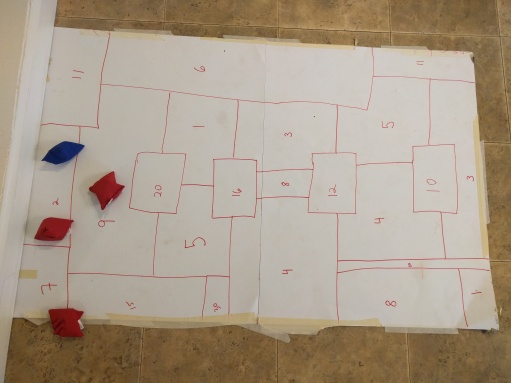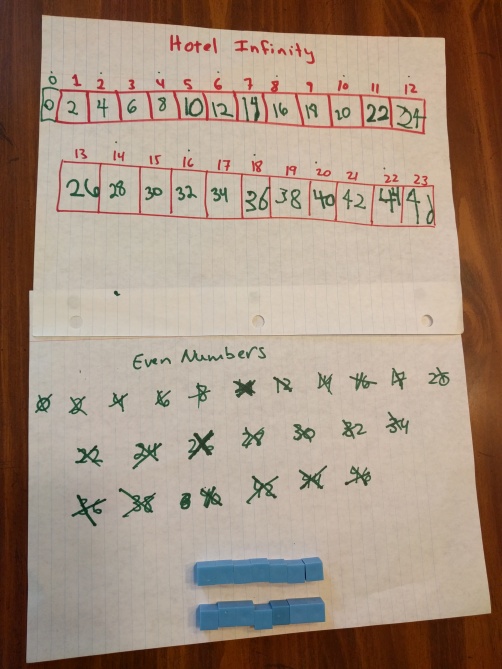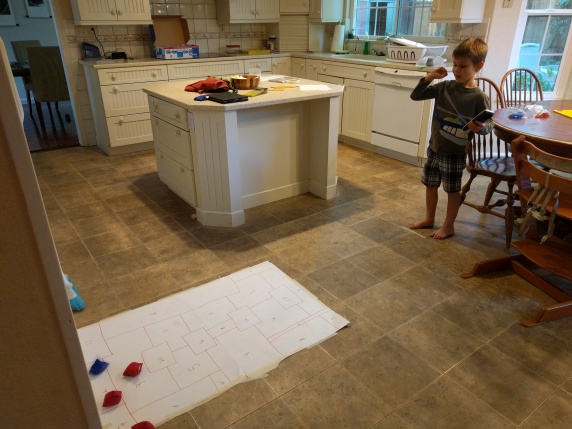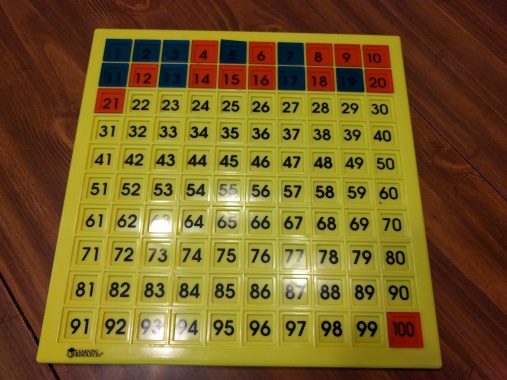The Activities
- Topic: Infinity, Even and Odd. Book: The Cat in Numberland ,Chapter 4, by Ekelund. In this chapter, Mr Hildebrand wants exactly one half of the numbers to go visit the letters. But how do we take one half of infinity? Later, the hotel is half empty because all the odds have gone. How can the evens move down so there are no lonely, empty rooms? We acted this part out with a diagram.
- Topic: Addition. The kids took turns throwing bean bags at a number chart on the floor. Then they used based-10 blocks to add up the three numbers. Once all the kids had their sum, we all jumped together, and each kid stopped jumping when we got to their sum. This means the kid with the highest sum gets to jump the longest.Which, believe me, was considered quite a high reward 🙂

- Topic: Primes and Composites. We worked to prove that various numbers between 1 and 100 were prime or composite. To prove something is composite, you should make a rectangle out of that many cubes. Proving something is prime is much harder, since you have to convince me that it is not possible to make a rectangle out of the blocks.
How did it go?
We had four kids this week. Everyone *loved* jumping, but my son had to sit out a couple activities because he was bored/wild/frustrated. Everyone else was pretty excited, especially about the beanbag addition.
Hotel Infinity
There were several interesting discussions this week. The hotel owners, the Hildebrands, decide that half of the numbers should go to visit their friends for one week. How do we make sure exactly half of all numbers go? One kid had a great suggestion: send the negative numbers away, and keep the positives. I was very impressed by this idea, but in this book, there are no negative numbers. Someone also suggested sending the numbers away, 50 at a time. I pointed out that this would definitely not be half of the number. And, we had yet another discussion about whether there is a biggest number. I think I (again) convinced them that we can always make a higher number, so there is no biggest.
The next part of the book is about the even numbers being lonely because the odd rooms are empty. Zero figures out that each even number can divide itself in two, and move into that room. We made a diagram of the hotel, and worked to divide the evens in half to find their new room number.
Three of the kids figured out the new room number by making two equal rows of base 10 blocks. For example, above we see that ’14’ will go to Room 7. Then the kid would write the number in the correct number, and cross it off the list. I gave out numbers in a random order, so it would not be obvious which room each belonged in.
My son got pretty impatient with this, because he could divide the numbers in his head, and just wanted to write them all into the hotel. After 2 or 3 numbers for each kid, we filled in the rest of the hotel by counting by twos and filling in the empty.
Bean Bag Addition
Everyone was excited to throw the bean bags at the chart. All four kids were able to add three numbers between 1 and 30 together, using base ten blocks. There were a few adding mistakes, but these were easily corrected.
After each kid added up their number we discussed who had the highest and lowest numbers, and then we all started jumping. When we got to each kid’s number, they had to stop jumping. At the end, it was just me and the kid with the highest number who were jumping. Everyone absolutely loved the jumping part, and desperately wanted to get the highest number. The highest number of the day was 64, and all the kids knew exactly who had gotten it.
This caused some problems for my son, who kept wanting to redo his throws to try to get higher numbers. Also, the adding was too easy for him. Initially I told him to multiply his three numbers, but his first set was 5 * 12 * 12. He knew 12*12 = 144, but 144 * 5 was pretty hard for him. This frustrated him, and eventually he decided he wanted to add his numbers like everyone else was doing.
We played 3 rounds of this game, and the last round we used 5 bean bags instead of 3. The kids all cheered when I asked if they wanted 5.

Primes and Composites
Last week David and the kids tested which number 1 – 14 were prime. This week one girl was able to explain that a number is prime if you cannot make a rectangle out of that number cubes (unless one side is just one block wide).
This week, we explored some of the numbers above 14. We tracked our progress on the 100 board, using a blue square to indicate prime numbers and red to indicate composites. I just told them which were prime this time, but made them prove the composites by making a rectangle.

The kids started to ask to do very large numbers like 99. Unfortunately it takes forever to count out 99 cubes. In a future week I might do it ahead of time, and let each kid try one big number.